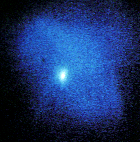Take a Journey of Discovery with RXTE - Classroom Activity

Neutron Stars
A neutron star is one of the endpoints of stellar evolution. When a very massive star dies, it spews its outer layers into space in a violent explosion called a supernova. The core of the star may remain as a neutron star.
A neutron star resulting from a supernova must have a mass between 1.4 and 3 solar masses. Beyond 3 solar masses, not even the tightly packed neutrons that make up the star can withstand the star's gravitational pull.
Pulsars
Pulsars, it is believed, are spinning neutron stars that emit beams of radiation at regular intervals. The beams are created by the pulsar's very intense magnetic field, about 1,000,000,000,000 times stronger than Earth's.
Pulsars were first discovered in late 1967 as radio sources that blink on and off at a constant frequency. Now we observe the brightest ones at almost every wavelength of light, including X-rays! An X-ray pulsar generates regular pulses of radiation at X-ray wavelengths. This kind of pulsar pulls matter from a companion star in orbit around it. The matter is pulled into a disk that rotates around the pulsar, called an accretion disk. It is heated up to millions of degrees, producing X-rays. This mechanism of X-ray production is the same as in a black hole system.
Below, we see the famous Crab Nebula, an undisputed example of a neutron star formed during a supernova explosion. The supernova itself was observed in 1054 A.D. These images are from the Einstein X-ray Observatory satellite. They show the Crab Nebula and its pulsar in both the "on" and "off" states, i.e. when the magnetic pole of the pulsar is "in" and "out" of the line-of-sight from Earth.
 |
 |
For more information about pulsars read: http://imagine.gsfc.nasa.gov/docs/introduction/pulsars.html


